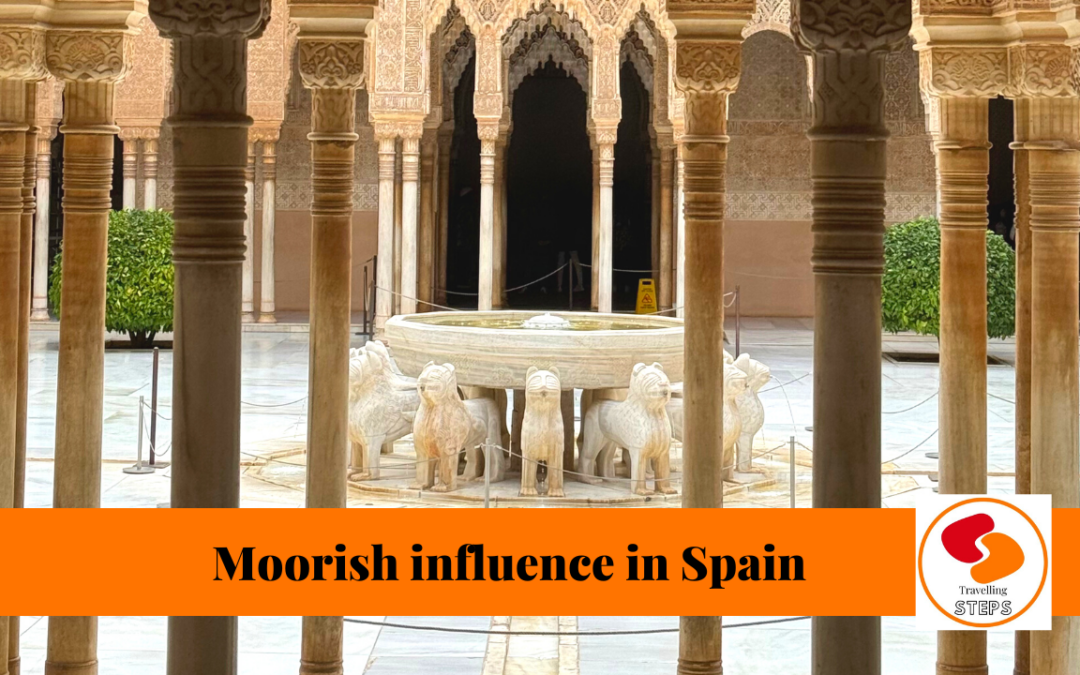Spain, is known for its vibrant culture and rich history, bears the indelible marks of diverse civilizations that have shaped its identity. One of the most profound influences on Spain was the Moorish era (711 – 1492), a period that left an enduring legacy on my home country.
The Moorish influence in Spain dates back to the 8th century when Muslim forces, led by the Umayyad Caliphate, crossed the Strait of Gibraltar and established their presence on the Iberian Peninsula. This marked the beginning of a nearly 800-year era, during which Islamic culture, science, and architecture flourished in the region. The Moors, a term used to describe the Muslim inhabitants of Al-Andalus, as they named the territory, brought with them a sophisticated civilization that significantly influenced Spain.
Architectural Marvels
One of the most tangible legacies of the Moorish presence in Spain is the breathtaking architecture that graces cities like Cordoba, Granada or Seville. The Alhambra, a palace and fortress complex in Granada, stands as a testament to the Moorish mastery of design and aesthetics. Its intricate geometric patterns, courtyards, and gardens reflect the fusion of Islamic, Christian, and Jewish artistic influences.
The Great Mosque of Cordoba, initially constructed in the 8th century, exemplifies the architectural prowess of the Moors. While the structure underwent modifications after the Christian Reconquista, its horseshoe arches, ornate mosaics, and the iconic red and white striped double arches called “voussoirs” still take my breath away.
In Sevilla, we find the magnificent tower of La Giralda. Long time ago, it was the minaret of the mosque. The tower where the almoecin called to prayer five times per day. Once the city was reconquered in 1248, the mosque came down, but not the tower (I guess it was too beautiful) and it was reused with the same purpose. It became the bell tower of the Cathedral, also calling for prayer. Same use, but for a different God.
Culinary Fusion
Moorish influence is not confined to Spain’s physical structures but extends into its culinary landscape. The Moors introduced an array of exotic spices, fruits, and cooking techniques that transformed the Iberian Peninsula’s gastronomy. A dish as Spanish as the paella, showcase the Moorish legacy through the use of saffron and rice – ingredients brought by the Moors from their voyages to the Middle East.
Even the concept of tapas, can also be traced back to the Moors. The tradition of serving small portions of food to accompany beverages aligns with the Moorish practice of combining food and socializing.
If you visit southern Spain, you will need to eat pescaito frito. These are all the different fishes you can imagine deep fried. The Moors who came to Spain loved to deep fry everything, even their desserts. One of andalucian delicacies are the pestiños, a very humble dough, that once it is fried, it is covered in honey. Unfortunatelly, I am allergic to honey, so I have never tasted them, but my kids love them.
Language
The Spanish language itself bears the imprint of Moorish influence. Thousands of Spanish words have Arabic roots, attesting to the linguistic interchange that transpired during the Islamic rule. Furthermore, many literary works from the Spanish Golden Age (XVI -XVII), such as the writings of Miguel de Cervantes, were influenced by Moorish storytelling traditions.
In our vocabulary, any word that starts with the particle “al” has a Moorish root. Words as “alcachofa” (artichoke), “almohada” (pillow) and of course the word Alhambra, which means the red castle, all of them are Moorish heritage.
Agricultural Advancements – Economy
One of the big economical motors in Spain is the agriculture, and yes, we owe part of the Spanish knowhow to them. The Moors revolutionized agriculture by introducing innovative irrigation systems and cultivating crops like citrus fruits, rice, and sugarcane. The iconic orchards of Andalusia owe their existence to the Moors’ expertise in water management, which transformed arid landscapes into fertile grounds.
Althoug many centuries have passed since the Moors ruled Spain, their influence resonates in my country’s contemporary way of life. From the architectural marvels that attract tourists worldwide to the daily rituals embedded in Spanish culture, the Moorish legacy endures. It is a living testament to the power of cultural exchange. As Spain continues to evolve, the Moorish influence stands as a reminder of the richness that arises when diverse civilizations converge and coalesce, creating a unique and timeless identity.







